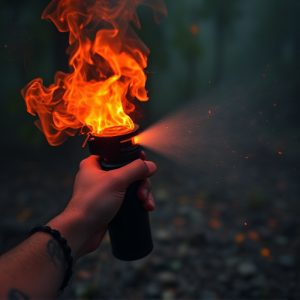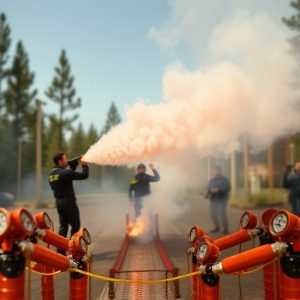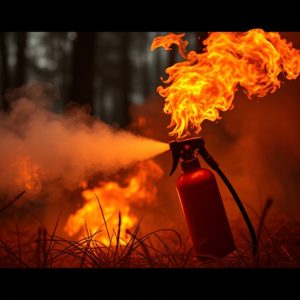Optimizing Wildfire Pepper Spray in Firefighting and Law Enforcement Operations: A Guide and Best Practices
Wildfire pepper spray serves as a vital non-lethal tool for law enforcement, offering specialized in…….
Wildfire pepper spray serves as a vital non-lethal tool for law enforcement, offering specialized incapacitation during confrontational situations. This potent spray, containing oleoresin capsicum, induces intense irritation upon contact with mucous membranes and skin, temporarily disabling individuals by causing a burning sensation in the eyes, nose, and throat, thus enabling crowd control and de-escalation of volatile encounters without resorting to lethal force. Its effectiveness is dependent on proper selection between aerosol sprays or gel applications based on environmental factors and proximity to the subject. Law enforcement agencies also use wildfire pepper spray to protect personnel from threats during wildland fire challenges, acting as both a human and animal repellent to secure perimeters and ensure the safety of firefighters combating blazes. To effectively utilize this tool, officers require comprehensive training that covers its application, chemical properties, legal considerations, and post-application protocols. Agencies must maintain proficiency in wildfire pepper spray use through ongoing training, clear procedures for decontamination and medical care, and by staying informed on the latest best practices to minimize harm and maximize situational awareness.
Exploring the intersection of public safety and environmental stewardship, this article delves into the multifaceted role of wildfire pepper spray in both law enforcement and wildland firefighting. Known for its potent non-lethal capabilities, wildfire pepper spray emerges as a critical tool in various operational scenarios. We will navigate its application within law enforcement contexts, scrutinize its efficacy during wildland firefighting endeavors, and provide essential training guidelines to ensure optimal use by authorities. Join us as we dissect the significance of this versatile safety measure.
Understanding Wildfire Pepper Spray: A Comprehensive Guide for Law Enforcement
Wildfire pepper spray is a specialized form of self-defense and crowd management tool designed for law enforcement personnel. This potent spray contains a high concentration of oleoresin capsicum, commonly known as OC, which induces an immediate and strong irritation upon contact with mucous membranes and skin. When deployed effectively, it incapacitates individuals by causing a burning sensation in the eyes, nose, and throat, temporarily impairing vision, respiration, and the ability to perform violent actions. This allows law enforcement to manage confrontational situations without resorting to lethal force.
Understanding the nuances of wildfire pepper spray is crucial for its effective use by officers. It comes in various formulations, which can be delivered through different means such as aerosol sprays or gel-based applications. The choice between these depends on factors like wind conditions, proximity to the subject, and desired range of effect. Proper training is essential for law enforcement to handle this tool safely and effectively, ensuring its role as a non-lethal alternative in de-escalating volatile encounters. A comprehensive guide for law enforcement should cover the legal implications, proper storage and maintenance, and the best practices for deployment in various scenarios, emphasizing the importance of wildfire pepper spray as part of a broader strategy for public safety.
The Efficacy of Wildfire Pepper Spray in Wildland Firefighting Operations
Law enforcement agencies facing the challenges of wildland firefighting have increasingly turned to wildfire pepper spray as a versatile tool for protection and operational effectiveness. This highly effective formula, designed specifically for managing wildfires, provides an invaluable resource for first responders who encounter unpredictable conditions while combating these natural disasters. The pepper spray is engineered with a potent concentration of oleoresin capsicum, which acts as a deterrent to both humans and animals, effectively deterring looters or wildlife that may inadvertently interfere with fire operations. Its application can be critical in protecting personnel and securing the perimeter around a fire site, allowing for uninterrupted efforts to contain and extinguish the blaze. Furthermore, the long-lasting effects of the spray can incapacitate intruders or animals for extended periods, creating a safer environment for firefighters to work without the threat of external dangers. The strategic deployment of wildfire pepper spray has proven its efficacy in enhancing the safety and efficiency of wildland firefighting operations, making it an indispensable tool in the arsenal of law enforcement agencies dealing with such emergencies.
Training and Best Practices for Law Enforcement Utilizing Wildfire Pepper Spray
Law enforcement agencies utilizing Wildfire pepper spray must prioritize comprehensive training for their officers to effectively and safely deploy this less-than-lethal tool. Proper handling and application techniques are paramount, as they directly impact the efficacy of the spray in crowd management or de-escalation scenarios. Officers should undergo rigorous training that includes recognizing appropriate situations for using Wildfire pepper spray, understanding its chemical composition and potential effects on individuals, and practicing with the equipment to become proficient in its use. This training should also cover the legal implications of deploying the spray, as well as post-application procedures to ensure public safety and the well-being of those affected by the spray.
Best practices for law enforcement in using Wildfire pepper spray extend beyond initial training; they require ongoing competency assessments and continuous education on new developments or techniques. Regular drills and scenario-based exercises help maintain an officer’s readiness to use the spray effectively while minimizing collateral impact. Additionally, agencies should establish clear protocols for decontamination, medical aid, and communication with both the affected individuals and bystanders. By adhering to these best practices and continuously refining their approach, law enforcement can enhance the safety of both the public and its officers when employing Wildfire pepper spray in various situations.


